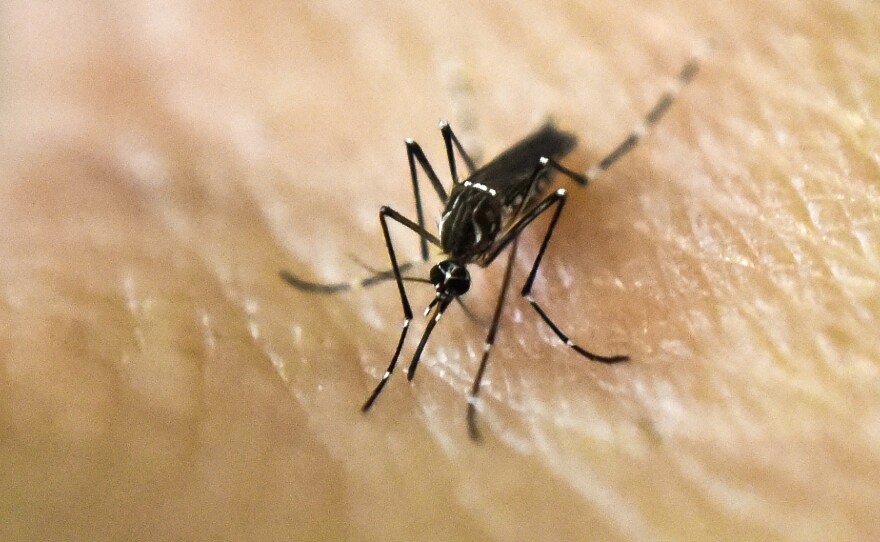
Aedes aegypti is the dog of the mosquito world. It acts as if it's man's best friend.
"It's been with us for a long time, probably for at least 5,000 years when we started keeping water next to our homes [ideal for laying eggs] and it's adapted to people," says Marten Edwards, an entomologist at Muhlenberg College in Allentown, Pa. "It loves us. It loves our cities. It loves our blood. It functions very well with us."
There's just one problem. This mosquito makes us sick.
Aedes aegypti is the primary mosquito responsible for spreading the Zika virus that's sweeping through Latin America and the Caribbean. For a long time it was known as the "Yellow Fever" mosquito because it's the primary vector for the virus that causes yellow fever. Aedes aegypti also spreads dengue and chikungunya.
A promotional press release amid the media frenzy over Zika called Aedes aegypti "a heat-driven missile of disease." While the tiny bug might not be able to blow anything up, it is very efficient at delivering viruses from one person to another.
"It's not like a mosquito can just suck up a virus and immediately inject into somebody else," says Marten. "The biology of the virus is connected to the biology of the mosquito." The stomach of Aedes aegypti is a fertile place for the Zika virus to reproduce. "This doesn't happen in the vast majority of mosquitoes," he says. "So that's what makes the Aedes aegypti unusual."
The mosquito's feeding habits are another boon for virus spreading. In general, female mosquitoes bite people or other warm-blooded creatures because they need the blood to hatch their eggs. Most mosquitoes get some blood in one bite and get on with reproduction. But Aedes aegypti is what's known as a "sip feeder." It takes lots of little sips of blood from lots of people. So once an Aedes aegypti mosquito is infected with a virus, it's able to spread it multiple times in its two- to four-week life.
That's partly why Zika has spread "explosively," as the World Health Organization head Margaret Chan characterized it, in the Americas.
Globally there are thousands of different types of mosquitoes. Aedes aegypti primarily is found in the tropics. Entomologists say its habitat is expanding but currently its range extends from the southern United States to northern Argentina in the Americas. It prospers across sub-Saharan Africa, in India and in warmer, wetter parts of Southeast Asia. Basically Aedes aegypti hangs out in a wide band around the equator.
And it likes cities.
"This is an urban mosquito," says Audrey Lenhart, an entomologist with the Centers for Disease Control and Prevention in Atlanta. "It tends to breed in close proximity to human habitations." Trash is a favorite breeding site. So are abandoned tires because of the water trapped inside.
Other mosquitoes, by contrast, breed in swamps and feed off deer.
Lenhart is now part of the CDC's emergency response to the Zika outbreak. Her earlier work looked at how Aedes aegypti spreads dengue in Latin America and what can be done to control it.
"It's a tricky mosquito to control. It doesn't bite at night like the mosquitoes that transmit malaria, so bed nets are not necessarily useful. They rest both inside and outside houses so there's not an easy way to target the adult mosquito [with pesticide]."
"It's domesticated," says Rebekah Kading, an entomologist at Colorado State University. She reiterates that Aedes aegypti has developed a lot of habits that make it really good at spreading disease.
"It's feeding on people almost exclusively. It doesn't fly very far so it's just circulating virus in an area." Its flight span is about a quarter of a mile, according to one study.
How do we get rid of this unwanted friend?
The researchers interviewed for this story said that people need to make their homes and neighborhoods less friendly to mosquitoes. For example, dump out any containers with even a little standing water in the bottom — Aedes aegypti's larvae can develop in even a bottle cap full of water. And even without water, the eggs can survive for months, until the rains arrive.
As with any complex, long-term relationship, breaking up with Aedes aegypti may be hard for humans to do.
Copyright 2016 NPR. To see more, visit http://www.npr.org/.






